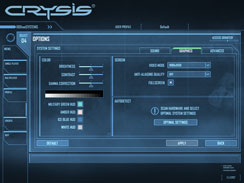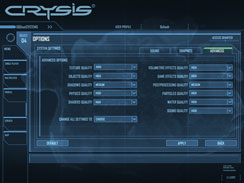Crysis
Publisher: Electronic ArtsWhat can we say about this game that hasn’t been said already? Crysis is probably the most anticipated game on the PC last year and was released on November 16th.
Crysis is seen by many as the poster boy for DirectX 10 and it will make your system cry, quite literally – it’s a monster! It doesn’t come as much of a surprise then, that the graphics are something special – they’re above and beyond anything we’ve ever seen in a PC game.
We tested the game under both DirectX 9.0 and DirectX 10 using a custom timedemo and is more representative of gameplay than the built-in benchmark, which renders things much faster than you’re going to experience in game. We found that around 25 fps in our timedemo was sufficient enough to obtain a playable frame rate through the game. It’s a little different to other games in that the low frame rates still appear to be quite smooth.
For our testing under DirectX 9.0, we set most of the in-game settings to high, with the only exceptions to this rule being shadow quality and post processing quality, which were dropped to medium quality. For DirectX 10 testing, we set shader quality to 'very high', while all other settings remained the same as what they were set to for our DX9 performance testing. Because of how intense the game is, we tested with both anti-aliasing and anisotropic filtering disabled for the time being. There is currently no support for anisotropic filtering in the game, but you can still force it from the driver control panel.
DirectX 9.0
Interestingly, the Asus EAH3870 TOP 512MB’s clock speed increase makes it almost as fast as Nvidia’s GeForce 8800 GT at both 1280x1024 and 1680x1050 in DirectX 9.0 mode, with most in-game settings—except for Shadows and Post Processing—set to high. In terms of average frame rates, you’d have trouble telling the two apart at either resolution – there’s literally one tenth of a frame per second difference between them.
Where the difference is is in the minimum frame rates, although again you’d be pushed to notice the difference in real-world gameplay scenarios. At 1280x1024 the difference is four frames per second, while at 1680x1050 this is reduced to just two frames per second – with the Asus EAH3870 out of favour in both cases.
In comparison to a stock-clocked Radeon HD 3870 512MB, the factory overclocked Asus card is around 10 percent faster – that’s not too shabby and falls reasonably in line with the expected price premium.
DirectX 10
Obtaining playable frame rates in DirectX 10 mode is a tricky balance of image quality and performance – even with the settings we’ve tested here at just 1280x1024, you’re right on the ragged edge of what we deem to be playable in this title. At 1680x1050, you’re going to have to make more compromises to improve the frame rates by around 50 percent – that’s what is needed to obtain respectable enough frame rates in this title.
In fact, we’d go so far as to say that you’ll get a better experience under DirectX 9.0 mode on a single Radeon HD 3870—or GeForce 8800 GT for that matter—if you’re playing this absolute monster of a title at 1680x1050.

MSI MPG Velox 100R Chassis Review
October 14 2021 | 15:04











Want to comment? Please log in.